Cam Rea: "Cyrus the Israelite"
Was Cyrus the Persian King of Israelite Origin? Along with various Tribes amongst the Medes and Persians?"
Does "Umman Manda" actually mean "People of Manasseh"?
"Cyrus the Israelite"

by Cam Rea
The Persian Empire at the Height of its Extension
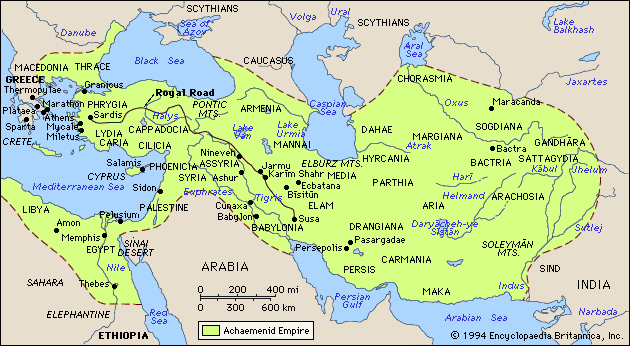
Cyrus the Israelite?
By Cam Rea
Introduction:
Cyrus the Great, a name that many historians and students of the
Bible are familiar with. Most of us know who Cyrus was and what he did both good
and bad. But, have we ever considered his origins? In this small article we will
examine Cyrus the Great and the various tribes that joined him in his rebellion
as well as his death.
Different Depictions of Cyrus and a Persian Symbol
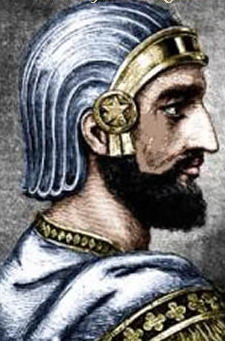
|


|
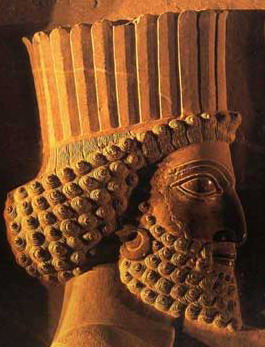
|
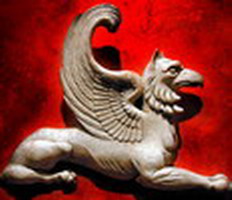
|
Cyrus the Great and the Median question:
Cyrus the Great who was the king of Persia was famous for freeing the Jews
and allowing them to return to their land and rebuild their temple. He is also
famous for conquering much of the Israelite territory before he freed the Jews
to return home. In 550 B.C.E Cyrus through off the Median/Scythian yoke and
rebelled against the Median/Scythian king named Astyages. This Astyages was the
last of the Umman-manda/Median kings and was consider to be a tyrant. Because of
his tyranny Cyrus with others revolted and won, and in doing so conquered the
Median/Scytho empire.1 Now before we go any further you may be asking how do I
get Medes and Israelites/Scythians in the same boat. For starters the Medes were
really not Medes. It seems that the archaic term was applied to exiles were ever
they were settled, and thus took on the name of the previous owner of the land
that was conquered. Now to fully understand this we must go back to the Assyrian
empire when Tiglath-pileser III was in power. This Assyrian king attacked the
Medes twice. The first time Tiglath-pileser III would deport 65,000 Medes from
the area. While the next invasion was another 154,000! Thus when added, the
Assyrian's captured and deported 219,000 Medes to other parts of the empire! But
also we must keep in mind that these numbers could be exaggerated. Also we need
to keep in mind that there may have been others taken along with the Medes who
were not Medes who were taken during the Assyrian invasion. Now since this area
is wide open and under Assyrian occupation, the region had to be filled. When
the Israelites were taken captive, Tiglath-pileser III sent many into this
Median territory to settle and live, and to breed child,produce goods, and to
defend the borders for the greater Assyrian empire. Because of this it seems the
exiled Israelites would take on archaic tribal, provincial, or even regional
names. But also it is quite possible that there were Medes, or type of Medes
living further east that were out of range from the Assyrian expansion, but also
it doesn't rule out the fact that there may have been roving bands of Medes
still in the area.2 Now to give you a better understanding we must look at the
inscriptions from both Persian and Greek. When Cyrus the Great began his
rebellion against the Median/Scythian empire Herodotus mentions some tribes that
took part with Cyrus:
"Now the Persian nation is made up of many tribes. Those which Cyrus
assembled and persuaded to revolt from the Medes, were the principal one on
which all the others are dependent. These are the Pasargadae, the Maraphii, and
the Maspii, of whom the Pasargadae are the noblest. The Achaemenidae, from which
spring all the Perseid kings, is one of their clans. The rest of the Persian
tribes are the following: the Panthialaei, Derusiaei, Germanii, all of which are
attached to the soil, the Daan, the Mardians, the Dropicans, and the Sagartians,
who are Nomads."3
Notice in the inscription that many tribes join him in his rebellion. The names
that are mentioned are of great significants. First name in the list is the
Pasargadae. Pasargadae means "Sons of Gad" and this tribe of Gad can be found in
the region of Carmania.4 What makes this tribe so interesting is that it's the
very tribe that the Achaemenid dynasty came from! Cyrus the Great was ether a
full blooded Israelite or half. In ether case Cyrus has Israelite blood and
belongs to the tribe of Gad!5 From the Pasargadae came the two other leading
tribes that seem to be the foundation of Persia, and that is the Maspii and
Maraphii. These three tribes together supplied the nobles and suppled the
officers for the army and the court, and most likely these three tribes were kin
to some extent due to the nature of their position among each other in terms of
relations.6 The next tribe mentioned that is recognizable is the Germanii or
Carmania. The Carmania are from the tribe of Reuben, and the name Carmania seems
to come from the Reubenite clan found in the book of Numbers chapter 26 known as
the Carmi. This Carmania is also called Germanii by Herodotus and can be found
in the region named by them called Carmania which is east of Persia. Also found
within the region of Carmani was the tribe known as Isatichae or Issachar. There
is very few sources on the Isatichae, but we do know they settled south of the
Caspian sea as well as east of the Caspian sea7 The Sagartians or Asakarta in
Persian are also from the tribe of Issachar. It's said that the Sagartians
settled around an oasis in Yazd and were known for their use of the dagger and
lasso. Also it's mentioned that they used no or little armor ether. This could
be due to the hot climate in the region. In a way they do resemble the American
Cowboy8. Now the next tribe that is mentioned is the Daan or Dai, and rendered
as Dahae in Persian or in old Persian "Daha".9 The tribe the Dahae came from
could be from the tribe of Dan do to the nature of the various spellings. But,
it is possible that they were from the tribe of Ephraim. For the Dahae seem to
be the Dahanites, and the name itself is similar to the Ephraimite clan known as
Tahanites found in the book of Numbers 26:35. This is due to similarity in
consonants based on the letters D and T.10 Now that we have examined some of the
tribes mentioned in the list it seems that the Scythians or Saka never were
conquered by Medes or left Media for the region is still crawling with Scythian
tribes from north to south, and east to west. Also Cyrus the Great seems to be
of full or partial Israelite blood, and to make matters interesting to the
reader, consider where Cyrus gained his Israelite blood. Cyrus' mother was a
Umman Manda princess named Mandane. This Mandane was the daughter of Astyages
who was king of the Umman Manda.11 Now princess Mandane name is of interest and
she could be named after two tribes, the first being Manasseh since her name
Manda is another possible and plusable for the name Manasseh due to the "d"
being changed or expressed like the letter "s". Thus Mandane becomes Mansae. The
other alternative to the Mandane is after the tribe of Dan do to the last
letters in her name dane which is another form of Dan or Dani or like the Danes.
But let me remind you this is pure speculation12. Now some may say "Umman Manda"
means Mede, but this doesn't seem to be the case. In one of the Persian inscriptions
the term "Umman-Manda" is used. Cyrus says he conquered them:
"He made the land of Gutium and all the Umman-manda bow in submission at
his feet."13
This term Umman-manda which is found in the Babylonian chronicles seems to
suggest a region of people who are all related to a certain extent. Before Cyrus
came to be, Cyaxares was leading them against Assyria. One would think that if
there was a shift in power by a different ethnic group it would have been noted.
But as stated before it seems that the Medes never threw out the Scythians,
but the Scythians were throwing out Scythians. As if and most likely due to a change
in power and politics rather than ethnicity. Now even though Cyrus had conquered
much of the Umman-manda many of them were still not subdued. It seems that many more lay
beyond his reach. One of these groups was the Massagetae.
The Eastern Sections of the Persian Empire
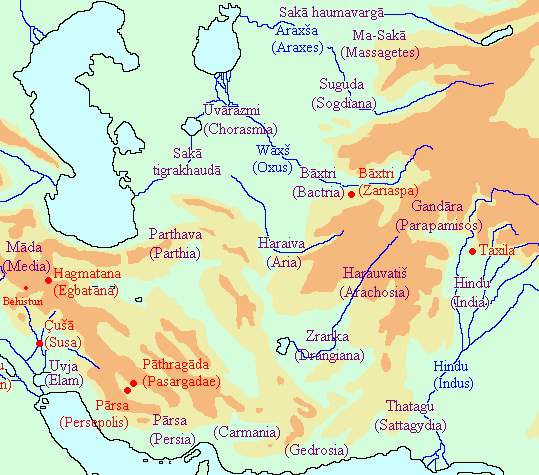
Cyrus meets the Massagetae:
Once Cyrus defeated Astyages and collected Astyages Umman-manda hordes, he
set out and took Babylon in a continued effort to ever expand his empire.
Reports from the north begin to filter down from outpost, to officer, to
courtier, to Cyrus, that the Saka are on the move and making raids. During the
next 9 years Cyrus has a series of forts built along his most northern frontier.
Most of these forts are newly found cities. The reason for this is due to the
Scythian raids disrupting the peace in the Persian empire. It seems that the the
border towns that were erected did not stop the Scythian raids which cause Cyrus
to make an expedition to the north to defeat and subdue the various Scythian
tribes that wreck havoc upon his land. This People of Massagetae Cyrus was going to face
was lead by a Queen named Tomyris. According to Herodotus Cyrus sent
ambassadors in an attempt to court her for Cyrus, but this is a joke. For Cyrus
had no need for her as a wife. In turn Tomyris did not allow the men to advance
and gave warning to Cyrus to not step foot on her territory. Cyrus does not
listen and goes in with a large army. Tomyris has her son Spargapises lead 1/3
of the Massagetae towards Cyrus forces. Cyrus leaves a small detachment behind
with food and drink; the Massagetae defeat the small Persian
army and begin to eat and drink what they had left. Once the Massagetae became
drunk Cyrus and his forces fell on the camp and killed many taking few prisoners
alive like Tomyris son Spargapises. Spargapises learning of what happened
committed suicide. Tomyris upon learning of what had happened considered the tactics of
Cyrus as cowardly. Tomyris vows revenge and Cyrus does not take heed to the
warning. Cyrus pushes further into Massagetae territory where he and his forces
meet up with the Massagetae face to face. In turn the Massagetae win the battle
and Cyrus's body is taken. Queen Tomyris has the head of Cyrus cut from his body
which she dips into blood as a symbolic act of revenge for her son. Now how
much of this is true and how much of this is false is up to the reader to
decide. Herodotus does seem plausible in his account. Also to support Herodotus
view as to what happen to Cyrus the Greek physician and historian Ctesias says
that Cambyses sent his court official named Bagapates to bring back the corpse of Cyrus
to Persia for funeral services.14 What ever happen to Cyrus on that fateful day
the end result was death indeed. But what makes this interesting and so ironic is that Cyrus
came from the tribe of Gad, and was killed in battle by his own kin the
Massagetae who were in turn the combined tribes of Gad and Manasseh.
1. Heschel, The Prophets, 184-185
2. Dalley, Myths from Mesopotamia, p. 285/ Sykes, A History of Persia, p. 118
3. Herodotus, The Histories, p. 70
4. Davidiy, The Tribes, p. 120
5. Boardman, The Cambridge Ancient History, p. 11
6. Rawlinson, A Manual of Ancient History: From the earliest times to the fall
of Rome, p. 85
7. Davidiy, The Tribes, p. 90, 116
8. Burke, Shahanshah: A Study of the Monarchy of Iran, p. 67
9. De Blois, Dahae I: Etymology", Encyclopedia Iranica, vol. 6, Cosa Mesa:
Mazda, p. 581
10. Collins, Parthia: The Forgotten Ancient Superpower And its Role In Biblical
History, p. 17
11. Herodotus, The Histories, p. 60
12. Davidiy, The Tribes, p. 30, 243
13. Pritchard, The Ancient Near East Vol 1, p. 206
14. Dandamaev, A Political History of the Achaemenid Empire, p. 67-68
Correspond with us
Send Comments or Criticisms
You may not always receive an immediate answer but anything you say will be considered and appreciated
Send us an
e-mail
Books and Offering Opportunities
Main Page







